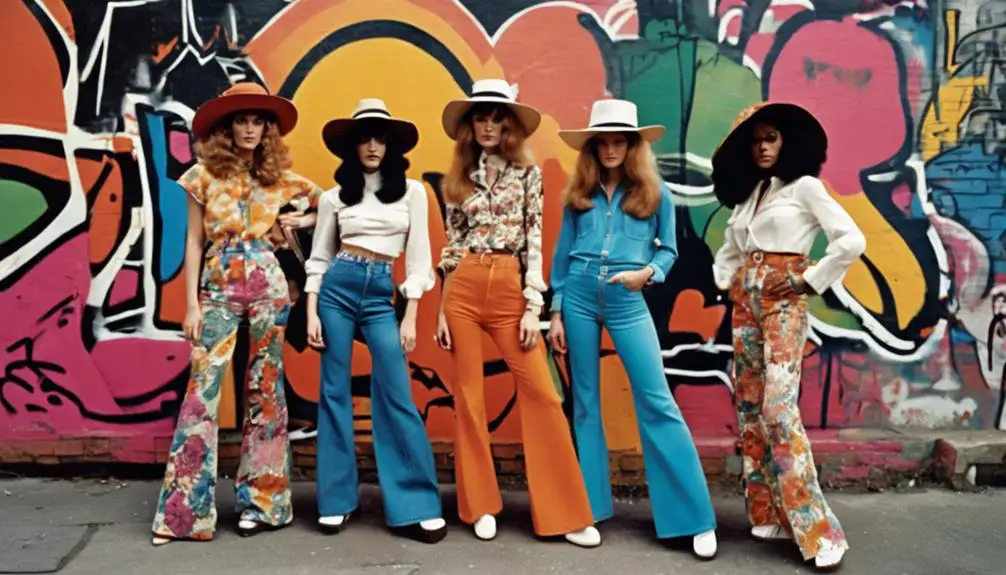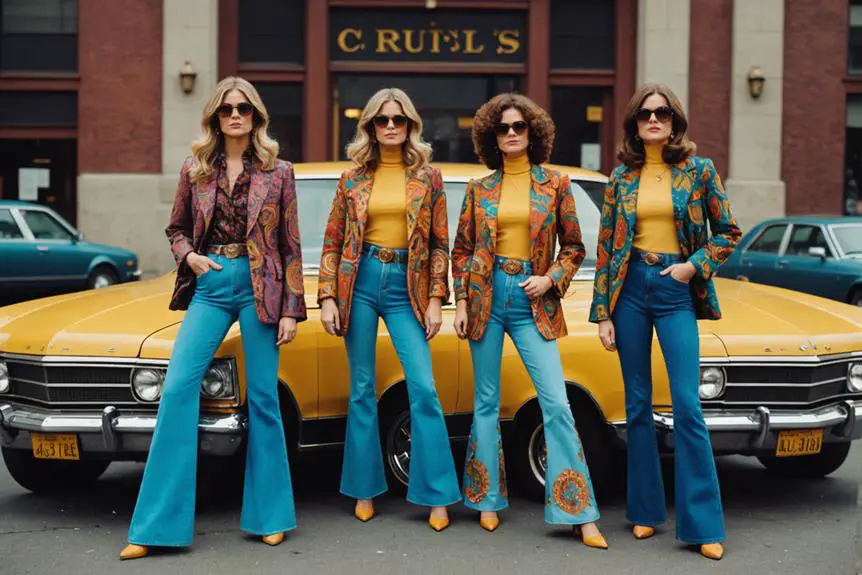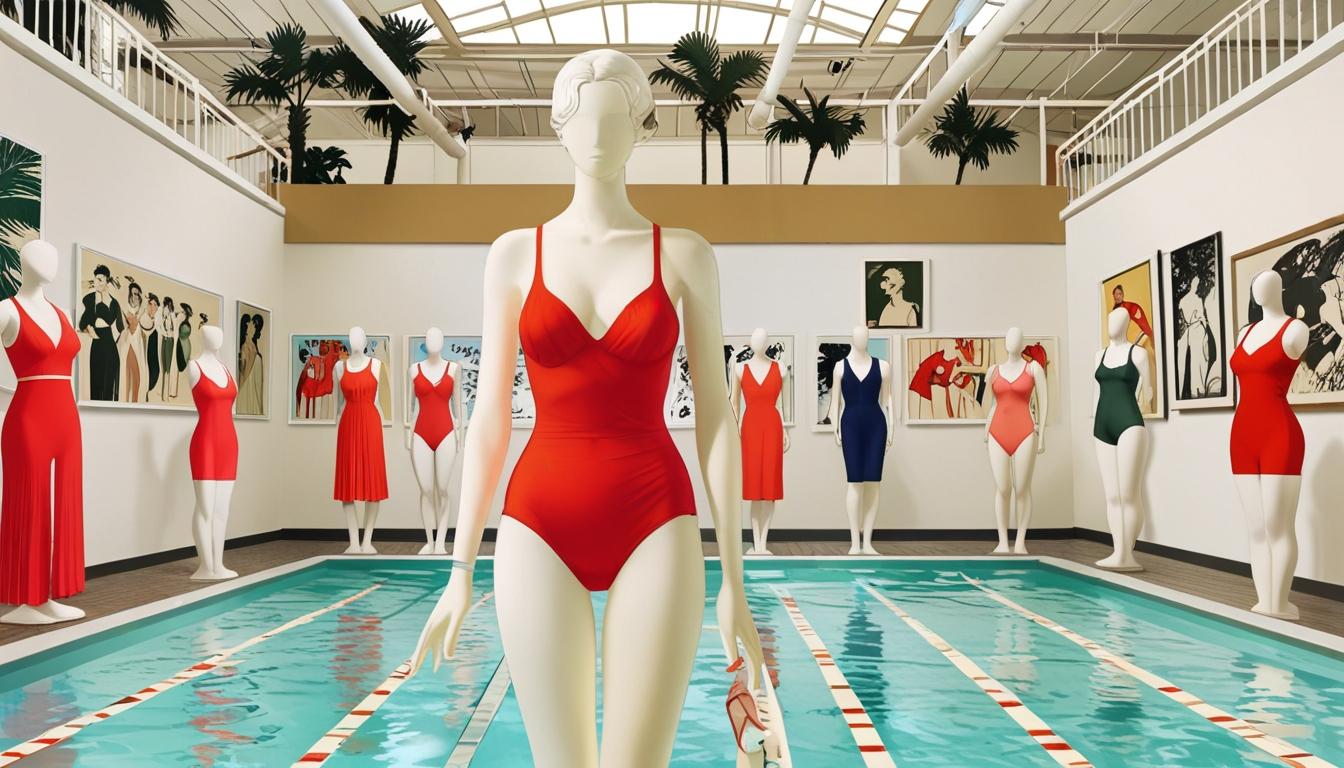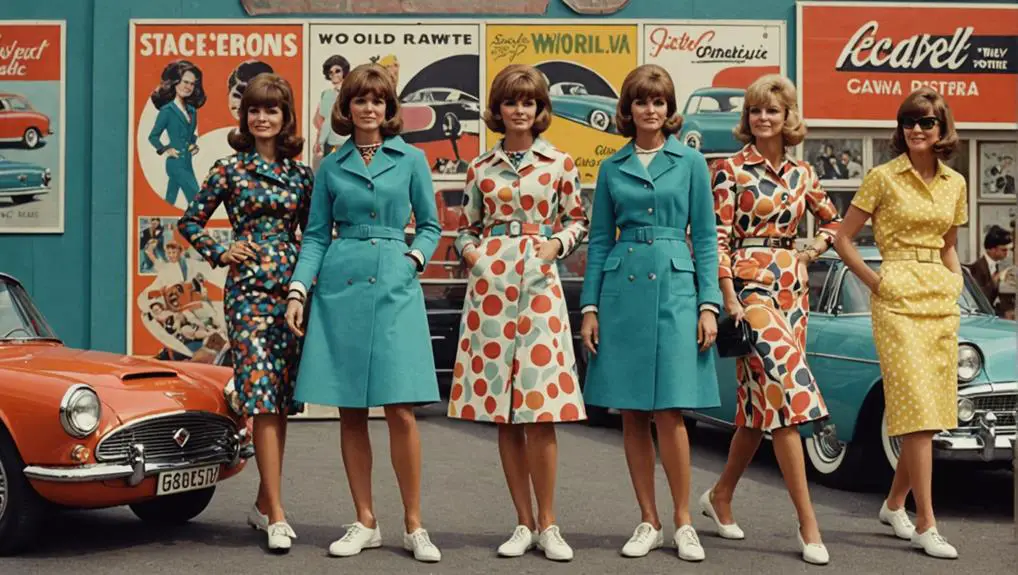Late 1970s fashion trends brought a thrilling mix of comfort and self-expression. You'd see women embracing relaxed silhouettes, like jersey wrap dresses and flowing maxi skirts, often in earthy tones and floral patterns. Men sported bold prints and leisure suits, blending style with ease. Unisex designs emerged, allowing kids to wear trendy denim and t-shirts together. Disco culture introduced body-conscious outfits made from shiny materials, while punk fashion rebelled against the norm. This era laid the groundwork for future fashion, celebrating individuality and creativity. Curious about how these trends shaped what we wear today? There's even more to discover about this fascinating time!
Key Women's Fashion Trends

In the late 1970s, you'd notice a shift in women's fashion toward more relaxed silhouettes that prioritized comfort and versatility. This era embraced styles like jersey wrap dresses and flowing maxi skirts, which allowed you to move freely while still looking chic. The influence of disco culture was undeniable, with body-conscious clothing made from synthetic fabrics like spandex becoming staples in wardrobes. Sequined tops and tube dresses added a touch of sparkle, perfect for those lively nights out.
Tailoring techniques for popular items like velvet blazers and bohemian tunics enhanced their fit and style, tailoring vintage pieces to reflect the trends of the time.
Earthy tones became the new norm, replacing the bright colors of earlier years. Muted shades and floral patterns reflected a natural aesthetic, making outfits feel grounded yet stylish. As leisurewear gained popularity, casual looks took center stage. High-waisted jeans paired with oversized sweaters offered comfort without sacrificing style, while comfortable footwear like sneakers and platform shoes made it easy to stay on your feet all day.
Accessories also saw a transformation during this time. Bold statement pieces, such as large floppy collars, chunky jewelry, and wide-brimmed hats, complemented the laid-back, bohemian vibe of late 1970s fashion.
These elements expressed individuality and creativity, allowing you to mix and match to create your unique look. Overall, the late 1970s was a dynamic period in women's fashion that celebrated comfort, versatility, and self-expression, making it a memorable time for style enthusiasts.
Influential Menswear Styles
As women's fashion embraced more relaxed silhouettes in the late 1970s, menswear followed suit with its own vibrant evolution. The era marked a significant shift in men's fashion, highlighting bold prints and vibrant colors. You could easily spot satin shirts paired with flared trousers, creating a look that was both striking and stylish. Notably, this period of fashion innovation mirrors the adaptability seen in brands like Fruit of the Loom as they expanded into diverse product offerings.
Leisure suits became a popular choice for casual outings, offering comfort without sacrificing style. Designer jeans surged in popularity during this period, transforming denim from mere workwear into high fashion. Brands like Calvin Klein and Gloria Vanderbilt played a vital role in this transformation, making jeans a staple in every man's wardrobe.
Meanwhile, men's suits began to feature slimmer cuts and softer materials, often incorporating luxurious fabrics like velvet, which reflected the growing preference for relaxed but chic styles. Footwear trends also took a turn towards the flamboyant, with platform shoes and ankle boots becoming must-have items. These shoes not only added height but also complemented the vibrant fashion choices of the time.
The late 1970s also ushered in a wave of gender-neutral fashion, blurring the lines between menswear and womenswear, allowing styles to appeal to everyone. This exciting period in menswear showcased a dynamic blend of comfort and style, paving the way for future generations to embrace bolder fashion choices with confidence.
Iconic Fashion Figures
The late 1970s were defined by a handful of iconic fashion figures who shaped the decade's style landscape. Mick and Bianca Jagger emerged as prominent symbols of this era, blending glamour and avant-garde style. Bianca's choice to wear a white Yves Saint Laurent tuxedo jacket on her wedding day captured the spirit of the time, showcasing fashion's ability to mix elegance with boldness.
The influence of vintage fashion identifiers during this period also played a significant role in defining personal style, as individuals sought unique pieces to express their individuality.
Halston, another key player, revolutionized evening wear with his luxurious, body-conscious designs. His flowing silhouettes and glittering sequins became the go-to for disco lovers, making a statement both on and off the dance floor.
At the same time, Diane von Furstenberg introduced the wrap dress, a versatile staple that celebrated the modern, empowered woman. This design not only offered comfort but also reflected the changing attitudes toward women's fashion.
As the decade progressed, punk fashion emerged, driven by figures like Vivienne Westwood and Malcolm McLaren. They challenged conventional styles with rebellious designs, featuring leather jackets, ripped clothing, and daring accessories.
This movement brought a raw edge to fashion that was both shocking and inspiring.
Giorgio Armani also made waves, launching his label in 1975, which focused on relaxed silhouettes and luxurious fabrics, reshaping menswear for a new generation.
These iconic figures and their contributions helped define the late 1970s, leaving a lasting impact on fashion that still resonates today.
Cultural Influences on Fashion
Cultural influences in the late 1970s transformed fashion into a vibrant expression of personal identity and collective movements. This era saw the emergence of disco styles, where body-conscious clothing made from shiny materials like spandex and sequins became all the rage. As you danced the night away, you'd likely find yourself in outfits that hugged every curve, reflecting the joyful spirit of disco culture.
The influence of popular brands like Tommy Hilfiger, which began to make waves in the fashion industry, can also be seen as part of this trend towards vibrant and expressive styles, emphasizing a connection to unique cultural identities and the significance of tag designs that signify different fashion eras.
At the same time, punk fashion was making waves as a bold counterculture statement. Tight black pants, leather jackets, and aggressive slogans dominated the scene, allowing you to express rebellion against mainstream norms. Music icons like David Bowie and the Sex Pistols played a vital role in shaping these trends, encouraging self-expression through their distinctive styles.
The cultural context of the late 1970s also played a significant role. With the end of the Vietnam War and the women's rights movement, fashion choices began to shift toward more empowering and versatile styles, where women included themselves in the conversation.
This newfound freedom extended to casual wear, making informal outfits acceptable in both social and professional settings. As you explored these fashion trends, you'd notice how they reflected broader societal changes, blending fun and function.
The late 1970s truly showcased how fashion became a canvas for self-expression, influenced by music, cultural movements, and individual empowerment. You weren't just wearing clothes; you were making a statement about who you were and what you believed in.
Evolution of Children's Fashion

During the late 1970s, children's fashion evolved dramatically, mirroring the vibrant styles of adults while fostering a unique identity for young wearers. This era marked a shift towards more inclusive and expressive styles, where bright colors and bold patterns became staples in kids' wardrobes.
You'd find children sporting casual t-shirts and denim jackets, reflecting the informal styles that were gaining popularity due to the influence of youth culture and music trends.
As you explore this fascinating evolution, consider these key elements of late 1970s children's fashion:
- Bright colors that caught the eye
- Unisex approach allowing for shared styles between boys and girls
- Leisure-inspired outfits made for comfort and play
- Preppy looks that introduced classic styles with a modern twist
The unisex approach led to both boys and girls wearing jeans and trousers, breaking away from traditional gender distinctions in fashion. Informal styles like screen-printed t-shirts became favored choices for playdates, while denim jackets added a cool edge to outfits.
As the decade progressed, preppy looks emerged, featuring more muted colors and classic designs, offering a contrast to the earlier flamboyant trends.
Ultimately, late 1970s children's fashion embraced comfort, creativity, and a sense of personal expression, laying the groundwork for the diverse styles we see today. This era truly celebrated the idea that fashion could be fun, functional, and a reflection of one's personality.




